
95% of researchers rate our articles as excellent or good
Learn more about the work of our research integrity team to safeguard the quality of each article we publish.
Find out more
ORIGINAL RESEARCH article
Front. Immunol. , 16 August 2022
Sec. Autoimmune and Autoinflammatory Disorders
Volume 13 - 2022 | https://doi.org/10.3389/fimmu.2022.940918
Background: Rheumatoid arthritis is a highly heterogeneous autoimmune disease characterized by unpredictable disease flares and significant differences in therapeutic response to available treatments. One possible reason for poor efficacy is that it cannot be treated accurately due to no optimal stratification for RA patients.
Objective: This study aims to construct an RA classification model by m6A characters and further predict response to medication.
Methods: Twenty m6A regulators were used to construct a random forest diagnosis model, and RNA-seq analysis was employed for external validation. The RNA modification patterns mediated by 20 m6A regulators were systematically evaluated in 1191 RA samples and explored different molecular clusters associated with other immune microenvironment characteristics and biological pathways. Then, we established an m6A score model to quantify the m6A modification patterns. The model was applied to patients at baseline to test the association between m6Ascore and infliximab responsiveness.
Results: The m6A diagnosis model showed good discriminatory ability in distinguishing RA. Patients with RA were classified into three clusters with distinct molecular and cellular signatures. Cluster A displayed strongly activated inflammatory cells and pathways. Specific innate lymphocytes occupied cluster B. Cluster C was mainly enriched in prominent adaptive lymphocytes and NK-mediated cytotoxicity signatures with the highest m6A score. Patients with a low m6Ascore exhibited significantly infliximab therapeutic benefits compared with those with a high m6Ascore (p< 0.05).
Conclusion: Our study is the first to provide a comprehensive analysis of m6A modifications in RA, which provides an innovative patient stratification framework and potentially enables improved therapeutic decisions.
Rheumatoid arthritis (RA) is a highly heterogeneous chronic autoimmune disease that is characterized by joint inflammation (1, 2). Several risk factors are known to be involved in the development of RA, including genetics, female sex, and environmental factors (3). Especially epigenetic regulation (4) is proposed to play an indispensable role in the occurrence and development of RA. Currently, conventional therapies, including conventional DMARDs, biological DMARDs, and targeted DMARDs, have substantially changed the course of RA (5). However, individual responses vary widely to treatment; 6%–21% of patients are refractory to multiple therapies, defined as refractory rheumatoid arthritis (6). Therefore, biomarkers are urgently needed to stratify patients and assess the benefits of from specific drug or class of drugs.
Epigenetics is a branch of genetics that refers to heritable chromosomal changes without nucleotide sequence alterations, including histone modification, DNA methylation, and RNA modification. As the third layer of epigenetics, more than 170 different types of RNA modifications, including N6-methyladenosine (m6A), 5-methylcytosine (m5C), and N1-methyladenosine (m1A), have been described (7). M6A is one of the most dominant RNA modifications in RNA. Like DNA or histone modification, m6A modification is a dynamic and reversible process in mammalian cells controlled by enzymes such as methyltransferases, demethylases, and binding proteins (8). Methyltransferase promotes m6A methylation modification to RNA, and demethylase removes the m6A-methylated group from RNA. RNA-binding proteins bind to the m6A methylation site in RNA to regulate mRNA metabolism and function (9). An in-depth investigation of these regulators would help uncover the role and mechanisms of m6A in gene posttranscriptional regulation (10, 11). Further, accumulating evidence indicated that not only m6A but also m6A regulators were correlated with disorders of multiple biological processes such as the occurrence of tumor (12), disturbance of immunomodulatory function (13), and systemic lupus erythematosus (14). In addition, m6A modification has been implicated in T-cell differentiation, homeostasis, and response to HIV infection (14). Considering the vital role of m6A modification in the immune response and immune cells, m6A may be involved in the etiology of RA. Studying epigenetic factors and mechanisms related to RA progression and treatment response is increasingly significant (15, 16).
However, the epigenetic modulation of single m6A regulators and the overall m6A modification characteristics in RA have not been fully understood. This study aims to revolve the patterns of m6A modifications of RA by performing a comprehensive analysis of the publicly available transcriptome datasets.
A total of 12 RA patients and five healthy controls (HC) were recruited for this study from the Second Hospital of Shanxi Medical University in August 2021. All the patients met the 2010 American College of Rheumatology (ACR)/European League Against Rheumatism (EULAR) classification criteria for RA (17). To evaluate the relationship between m6A and response to treatment, genome-scale data about infliximab therapy response were also recorded in our study, which included patients’ response to anti-TNF evaluated by Disease Activity Score-28(DAS28).
Peripheral blood samples (5 ml) were collected from each patient and control subject into EDTA-2 K-containing tubes. According to the manufacturer’s protocol, fresh PBMCs from each donor blood were isolated by Ficoll-Hypaque (Beijing Solarbio Science & Technology Co., Ltd.) density-gradient centrifugation for 20 min at room temperature. Total RNA was isolated from freshly obtained PBMCs. Before RNA sequencing, the quality of RNA was assessed on the Agilent Bioanalyzer 2100 system. A 1.5-μg RNA sample was taken for RNA sequencing. The library preparations were sequenced on Illumina. Removing reads containing adapter, containing ploy-N, and low-quality reads containing >50% bases with qualities of ≤20 from raw data, clean reads were obtained.
Reference genome and gene model annotation files were downloaded directly from the Genome website, and paired clean reads were aligned to the reference genome using Hisat2 v2.0.5. Reads mapped to each gene were calculated using featureCounts v1.5.0-p3. Then the FPKM for each gene was calculated.
Samples from the GEO cohort were randomly divided into the training set (935 samples, 70%) and the testing set I (400 samples, 30%). During training, to avoid the overfitting problem caused by random oversampling, the SMOTE sampling method was adopted to repeatedly sample the healthy controls, which had fewer samples, and thereby balance the number of samples in the RA and HCs. The R package “pROC” was used to evaluate the visualization of the receiver operating characteristic curve (ROC) to calculate the area under the curve (AUC). The sequencing data were employed for external validation.
Twenty-one acknowledged m6A regulator genes were referred (10, 18, 19). Only 20 regulators were stably expressed and used to identify distinct m6A methylation modification patterns. These 20 m6A regulators included eight methyltransferases (METTL3, METTL14, RBM15, RBM15B, WTAP, VIRMA/KIAA1429, CBLL1, ZC3H13), two demethylases (ALKBH5, FTO), and 10 RNA-binding proteins (YTHDC1, YTHDC2, YTHDF1, YTHDF2, YTHDF3, HNRNPA2B1, HNRNPC, FMR1, LRPPRC, ELAVL1). Unsupervised clustering analysis was applied to identify different m6A modification patterns based on these 20 m6A regulators by the “ConsensusClusterPlus” package. The optimal and stable numbers of clusters were selected according to cophenetic, dispersion, and silhouette coefficients.
To characterize the biological features between different m6A modification patterns, we utilized single-sample gene set enrichment analysis (ssGSEA) to estimate the population of specific infiltrating immunocytes and the activity of immune reactions. The gene sets marking each infiltrating immunocyte type were obtained from the previous study17, and the RA-related pathways were obtained from the MSigDB database. The enrichment scores defined by ssGSEA analysis represent the degree of each immunocyte abundance and immune reaction activity in each sample, compared to three distinct modification patterns by the Wilcoxon test.
M6A-related differentially expressed genes (DEGs) in different m6A phenotypes were identified by the “Limma” R package, in which P-values< 0.05 were set as cutoff criteria for the DEGs. GO and KEGG enrichment analyses were applied to analyze the biological significance of DEGs. P< 0.05 was considered statistically significant, and visualization of results was conducted by R package ‘ggplot2’ and ‘GOplot’.
To quantify m6A modification patterns in individual RA patients, we constructed a set of the m6A gene signature (m6Ascore) by using principal component analysis (PCA) algorithms. The differentially expressed genes (DEGs) obtained from three clusters in the previous step were intersected to get shared DEGs between three m6A clusters. Pearson correlations were performed to obtain positive or negative correlation signature genes for co-expressed DEGs. The signature genes were further selected for features by the “Boruta” R package. We then conducted PCA based on the final determining genes. Principal components from the two groups of signature genes were separately extracted and served as the final signature score by subtraction. This approach concentrates the score on the set with highly correlated or anticorrelated gene blocks while down-weighting the gene contributions that are not tracked with other set members. We then define the m6Ascore by adopting a formula like previous studies (18, 20, 21).
where i is the signature score of clusters that have a positive coefficient, and j is the expression of genes that have a negative coefficient.
A total of 1,203 RA and 149 healthy controls (HCs) from six cohorts were included in this study (Supplementary Table 1). PCA was used to visualize variation in correcting for batch effects (Supplementary Figure 1). We noticed a very close association among methyltransferases in the 20-m6A regulator protein–protein interaction (PPI) network, which usually function as a complex (Supplementary Figure 2). Subsequently, we explored the different expressions of 20 m6A regulators between RA and healthy controls in a GEO public cohort (Figures 1A–C). Five regulators were observed to have consistently different expressions in 12 RA patients and five HC participants from the Second Hospital of Shanxi Medical University ward and health examination center again (Figure 1D): FMR1, HNRNPC, LRPPRC, WTAP, YTHDF3. To examine the ability of the 20 m6A regulators to distinguish between RA and HCs, we conducted a diagnosis model by the random forest (RF) algorithm. The area under the curve (AUC) value was 0.83 (Figure 1E). External validation was performed for the diagnostic efficacy of the m6A-RF model (Figure 1F). Actually, this diagnostic model is not highly efficient in the validation cohort because of the insufficient sample size, but it also partly explains the role of m6A in the occurrence and development of RA.
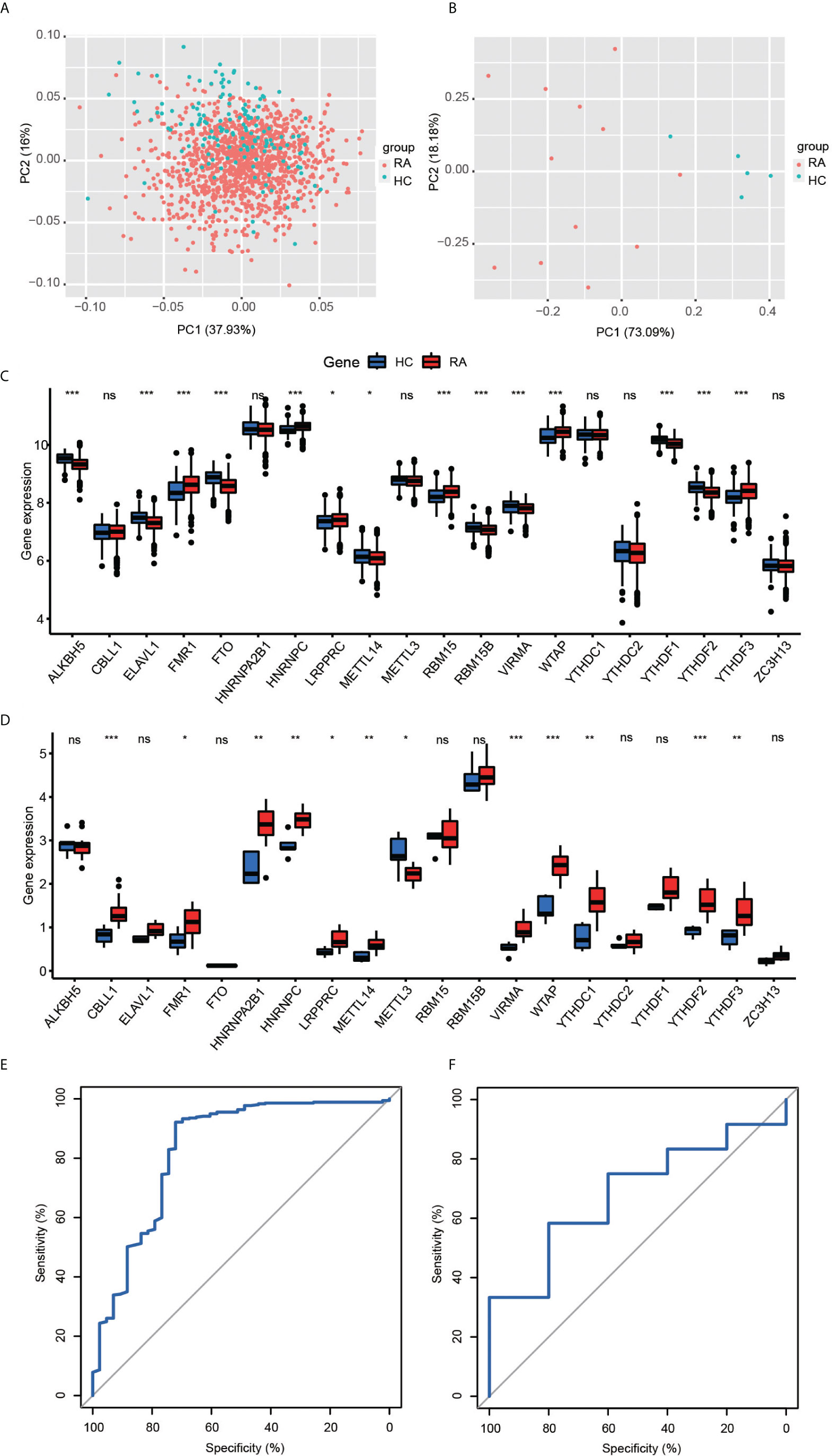
Figure 1 (A, B) Principal component analysis for the expression profiles of 20 m6A regulators could roughly distinguish RA from HC samples in the GEO cohort (A) and validation cohort (B). (C, D) The box plot demonstrated the 20 m6A regulators between healthy and RA patients in the GEO cohort (C) and clinical validation cohort (D) (*P < 0.05, **P < 0.01, ***P < 0.001, ns P >=0.05). (E, F) ROC curve of the 20 specifically expressed m6a regulators in RA samples. The 20-M6A feature random forest model predicted the testing cohort (E, AUC = 0.83) and validation cohort (F, AUC = 0.68).
To investigate transcriptome relationships, we calculated pairwise correlations among the expressions of the 20 m6A regulators. We found that positive correlations were more frequent than negative correlations (Figure 2A). Next, based on the expression profiles of the 20 selected m6A regulators, we utilized consensus clustering analysis to stratify patients to different m6A modification patterns (Figures 2B–D). Accordingly, we determined that the matrix heatmap retained sharp and clear sides when k = 3, which indicated there were three distinct m6A modification pattern clusters, including 279 cases in cluster A, 581 cases in cluster B, and 331 cases in cluster C (Figures 2E, F). We termed these clusters as m6A cluster A, m6A cluster B, and m6A cluster C.
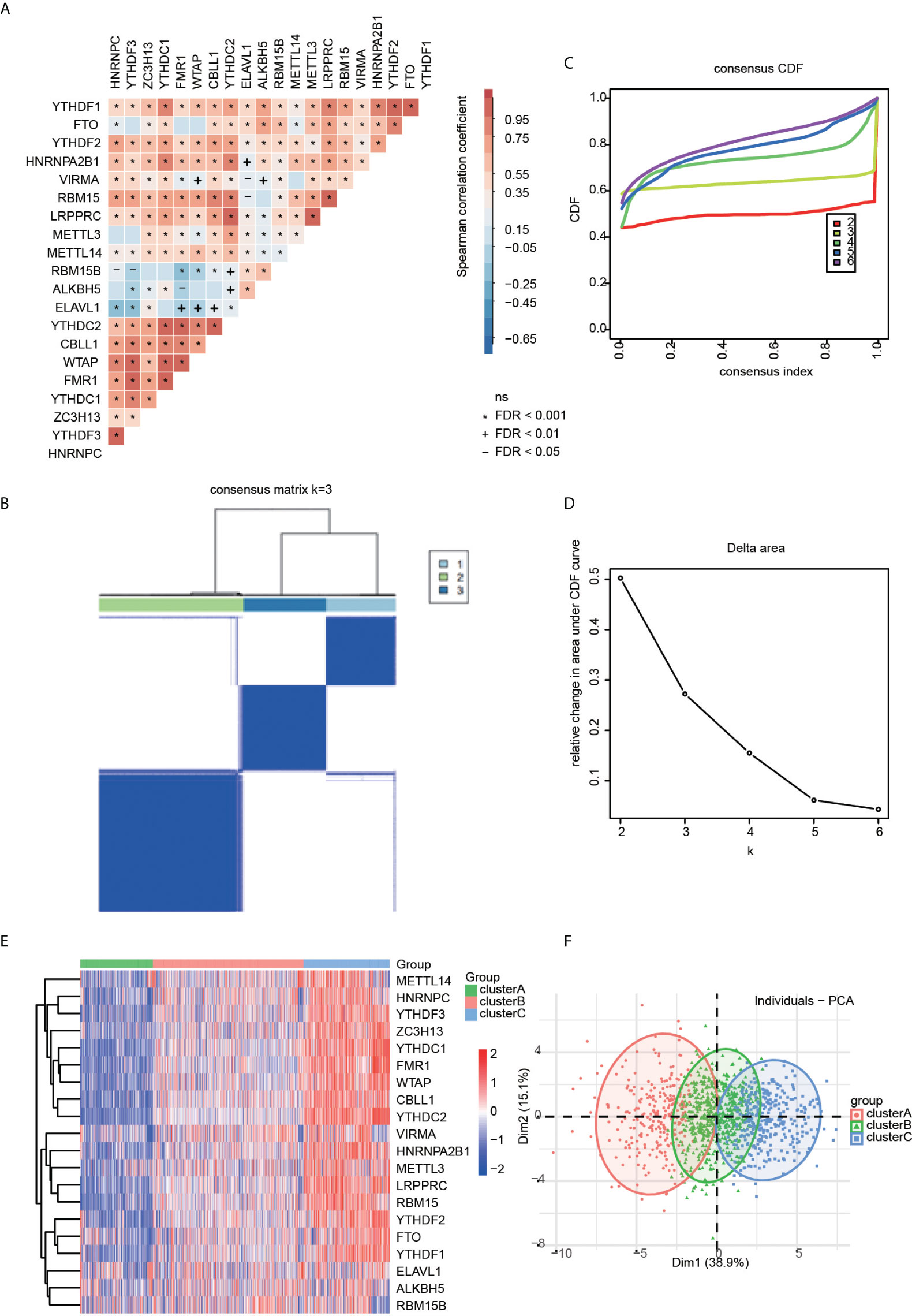
Figure 2 (A) Correlation heatmap for all 20 m6a regulators in RA patients. Some regulators were negatively related, represented in blue, and others were positively correlated, represented in red. The darker the color, the higher the correlation. (B) The consensus cluster matrix for k = 3 shows three major clusters. (C) Consensus clustering cumulative distribution function (CDF) for k = 2–6, which can completely describe the probability distribution of a real random variable. (D) The relative change of CDF Delta area curve for k = 2–6. (E) The distribution of 20 m6A RNA methylation regulators among three clusters. (F) Visualization of the clustering results through a scheme based on principal component analysis (PCA).
To identify the immune microenvironment characteristics underlying three distinct m6A modification patterns, we compared the enrichment scores of RA-related pathways and immune cell infiltration (Supplementary Tables 2, 3) among the RNA modification patterns. We found inflammatory cell infiltrates, including neutrophils, monocytes, and T helper type 17 (Th17) in cluster A, with the enormous imbalance between T helper type 1 and T helper type 1 (Th1/Th2) at the same time (Figure 3A). Patients in cluster C were rich in adaptive immune-related cells such as activated CD4+T cells, activated CD8+T cells, and activated B cells (Figure 3A). In cluster C, Th2 and eosinophil abundant infiltration was considered a protective factor by counteracting the development of arthritis and preventing bone loss20. Cluster B was modestly activated in most inflammatory and immune cells. Nevertheless, cluster B displayed more activation of natural killer cells (NK), natural killer T cells (NKT), gamma delta T cells (γδT), and CD56 bright natural killer cells (CD56bright NK), which are typical innate lymphoid cells. In parallel with this, the RA-related biological process was differentially activated in the three subgroups (Figure 3B). Cluster A showed strong enrichment for most inflammatory pathways, including acute and chronic inflammation, response to bacterium and virus, complement activation, and chemokine. Therefore, cluster A can be referred to as the highest inflammatory phenotype. In contrast, the abovementioned inflammatory pathways were remarkably less expressed in cluster C than in clusters A and B, and we assume cluster C as an adaptive lymphocyte-rich phenotype. Cluster B was enriched in natural killer cell-mediated cytotoxicity, IL-17 signaling pathway, JAK-STAT signaling pathway, and TNF signaling pathway. They were identified as an innate lymphocyte-rich phenotype.
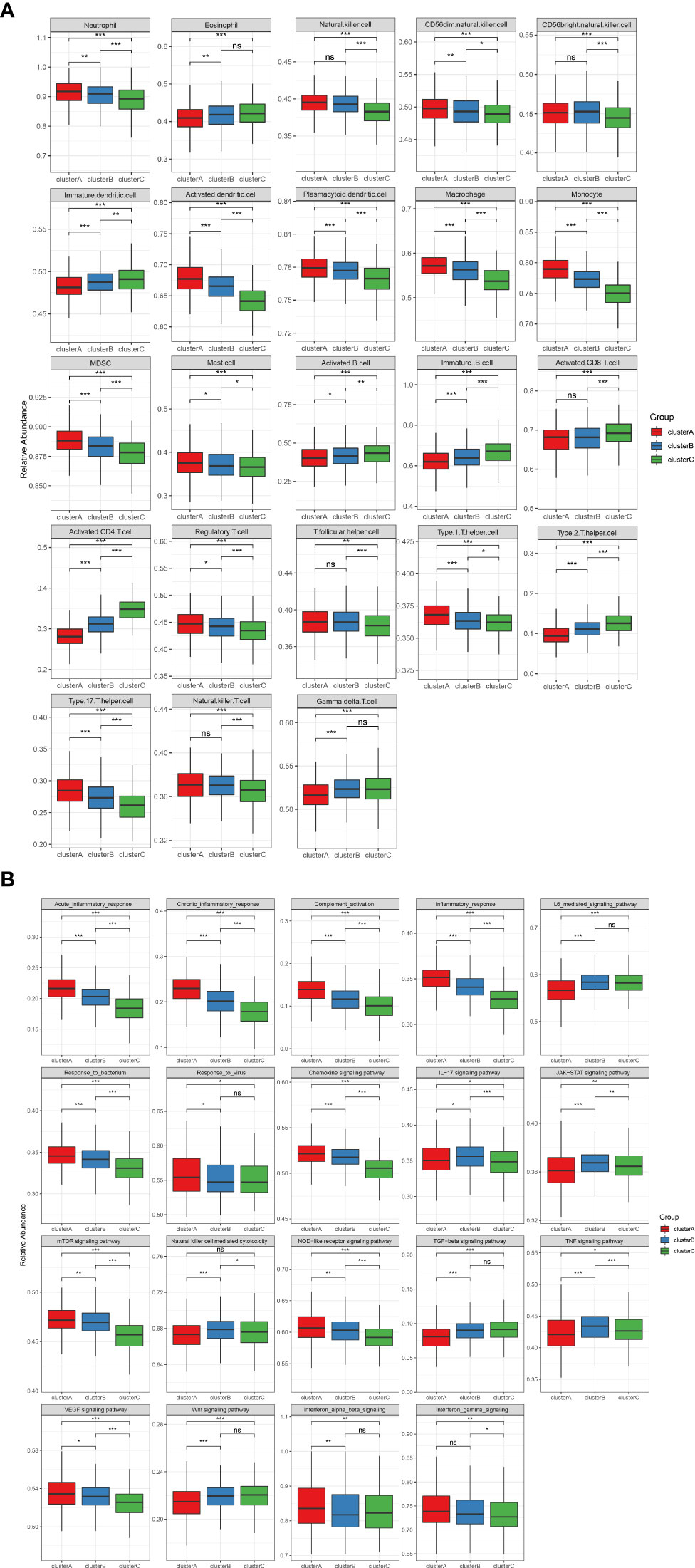
Figure 3 (A) The abundance of infiltrating immunocytes cells in the three m6A clusters. The upper and lower ends of the boxes represent the interquartile range of values. The lines in the boxes represent the median value, and the black dots show the outliers. The asterisks represent the statistical p-value (*P < 0.05, **P < 0.01, ***P < 0.001), ns P>=0.05. (B) Some rheumatoid arthritis-related immune reaction gene sets showed the activity differences in the three m6A clusters (*P < 0.05, **P < 0.01, ***P < 0.001), ns P>=0.05.
To determine whether the molecular cluster has an association with clinical features, we investigated the distribution of the three clusters according to disease activity (Figure 4 and Supplementary Table 4). Disease Activity Score (DAS)28 - erythrocyte sedimentation rate (DAS28-ESR) and DAS28-C-reactive protein (DAS28-CRP) larger than 5.1 were regarded as high disease activity. All three clusters existed independently of disease status. Therefore, the three clusters were similar and clinically indistinguishable by DAS28-ESR/DAS28-CRP parameters.
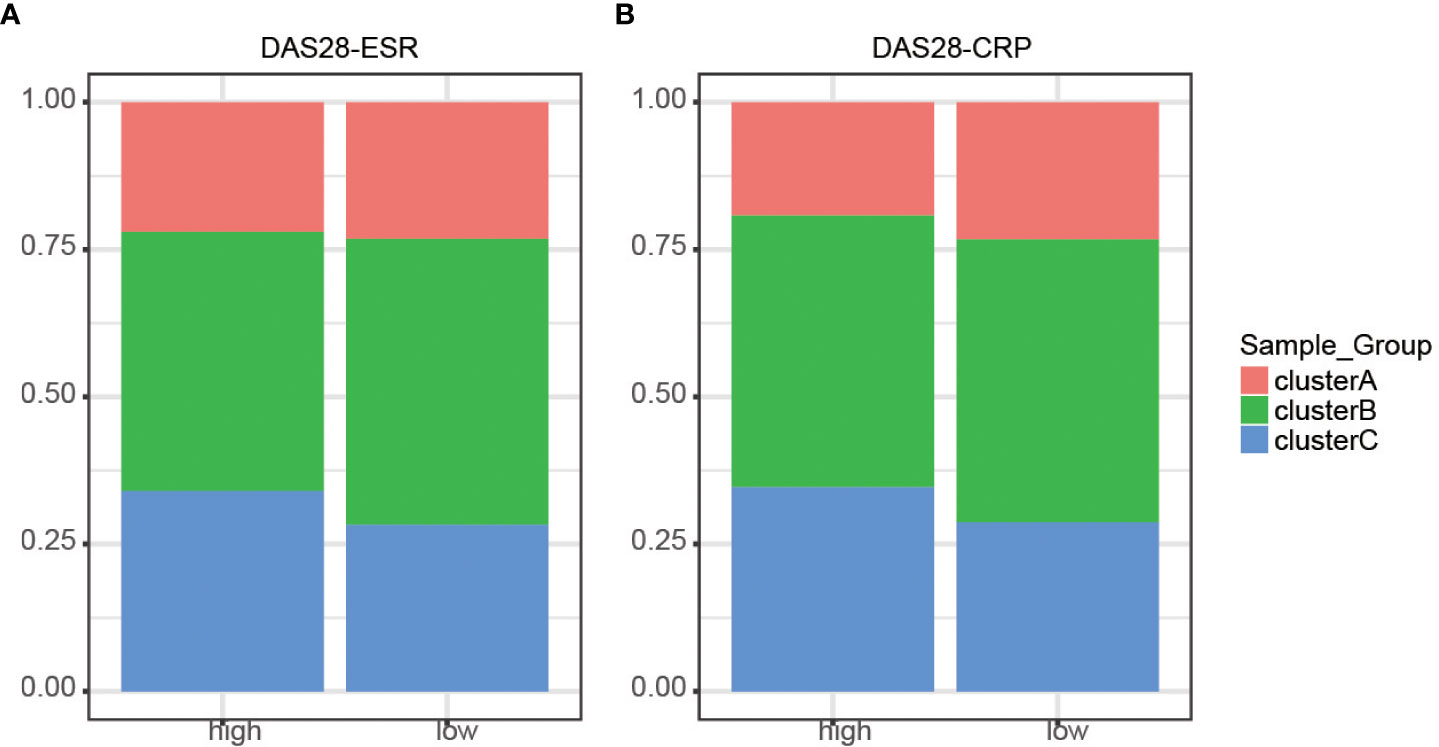
Figure 4 Distribution of disease activity scores between clusters. (A) DAS28-ESR showed no discrepancies identified in the three m6A clusters (P > 0.05). (B) DAS28-CRP showed no discrepancies identified in the three m6A clusters (P > 0.05).
Although RA patients were classified into three m6A modification phenotypes based on 20 m6A regulators, the underlying genetic changes and expression perturbations within these phenotypes remain unclear. To further examine potential m6A-related transcriptional expression changes in three patterns, we identified 209 overlapping DEGs using an empirical Bayesian algorithm and performed an enrichment analysis (Figure 5A). GO and KEGG pathway enrichment analyses were conducted to explore the functional characteristics of the DEGs (Figures 5B, C). The GO and KEGG analysis results showed that the DEGs were significantly enriched in “defense response to virus”, “response to interferon-beta”, “response to interferon-alpha”, “regulation of innate immune response”, “NOD-like receptor signaling pathway”, “Coronavirus disease-COVID-19”, and so on. We performed an unsupervised consensus clustering analysis based on the 209 RNA phenotype-related DEGs to further validate this differential regulation. Consistent with the clustering grouping of m6A modification patterns, we obtained three stable transcriptomic phenotypes named m6A gene clusters A–C (Supplementary Figure 3), consistent with the expected results.
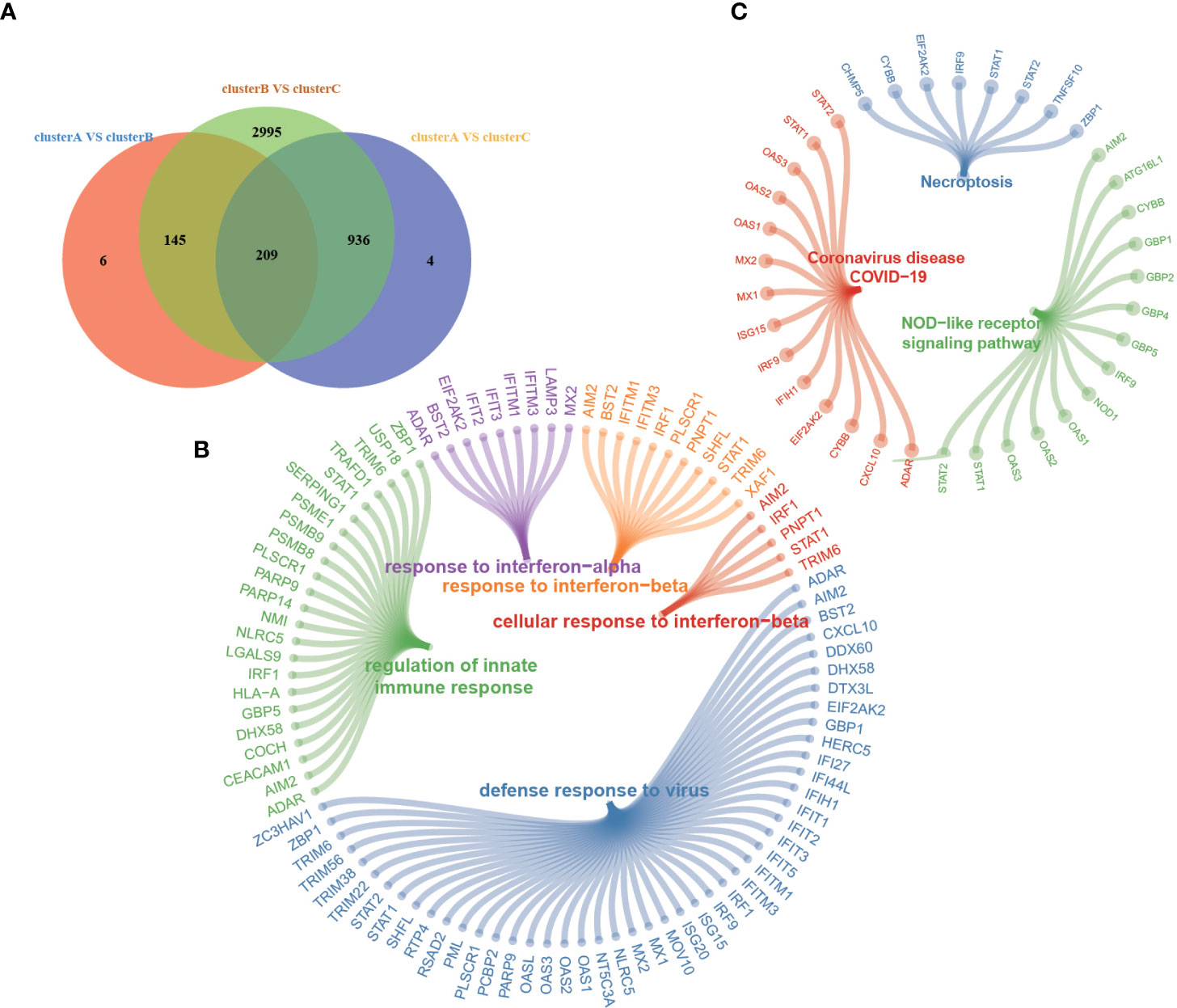
Figure 5 (A) Venn diagram shows 209 overlapping differentially expressed genes (DEGs) among the three m6A modification patterns. (B, C) Functional annotation for 209 m6A phenotype-related DEGs by GO (B) and KEGG (C) enrichment analyses. Each node represents one pathway or gene.
We applied the m6A score model to accurately evaluate the m6A modification pattern of individual patients with RA. Patients were divided into high or low m6A score groups using the median m6A score as the cutoff. In the two m6Ascore groups, almost all HLA gene expressions showed prominent differences, and that in m6Ascore-low was significantly higher than that of m6A score-high (Figure 6A). The m6Ascore-high group observed a significantly lower expression of 12 critical immune checkpoints than that in the m6Ascore-low group, like tumor necrosis factor superfamily15, tumor necrosis factor receptor superfamily14, CTLA4, and CD86 (Figure 6B). The above analysis indicated that m6Ascore might be closely connected with immunotherapy. To further understand the effects of m6Ascore on predicting drug response, we selected two independent groups, 154 RA patients treated with infliximab (Supplementary Table 5) and 92 RA patients treated with rituximab (Supplementary Table 6). We tested the differences in m6Ascore between infliximab responders and non-responders and found that responders had a lower m6Ascore, while patients showed a high m6Ascore with poor clinical efficacy of infliximab therapy (Figure 6C). The above analysis was in accordance with the expected results that the lower m6A score group, which has higher immune checkpoints TNFSF15 and TNFRSF14, may have a better anti-TNF (like infliximab) treatment effect. In cluster C, a higher m6A score was observed, which suggested that there may be a lower infliximab therapeutic response. Clusters A and B have lower m6A scores, and there may be higher infliximab therapeutic responses (Figures 6D, E). Nevertheless, the rituximab cohort study did not observe significant treatment differences between the two m6Ascore groups (Supplementary Figure 4).
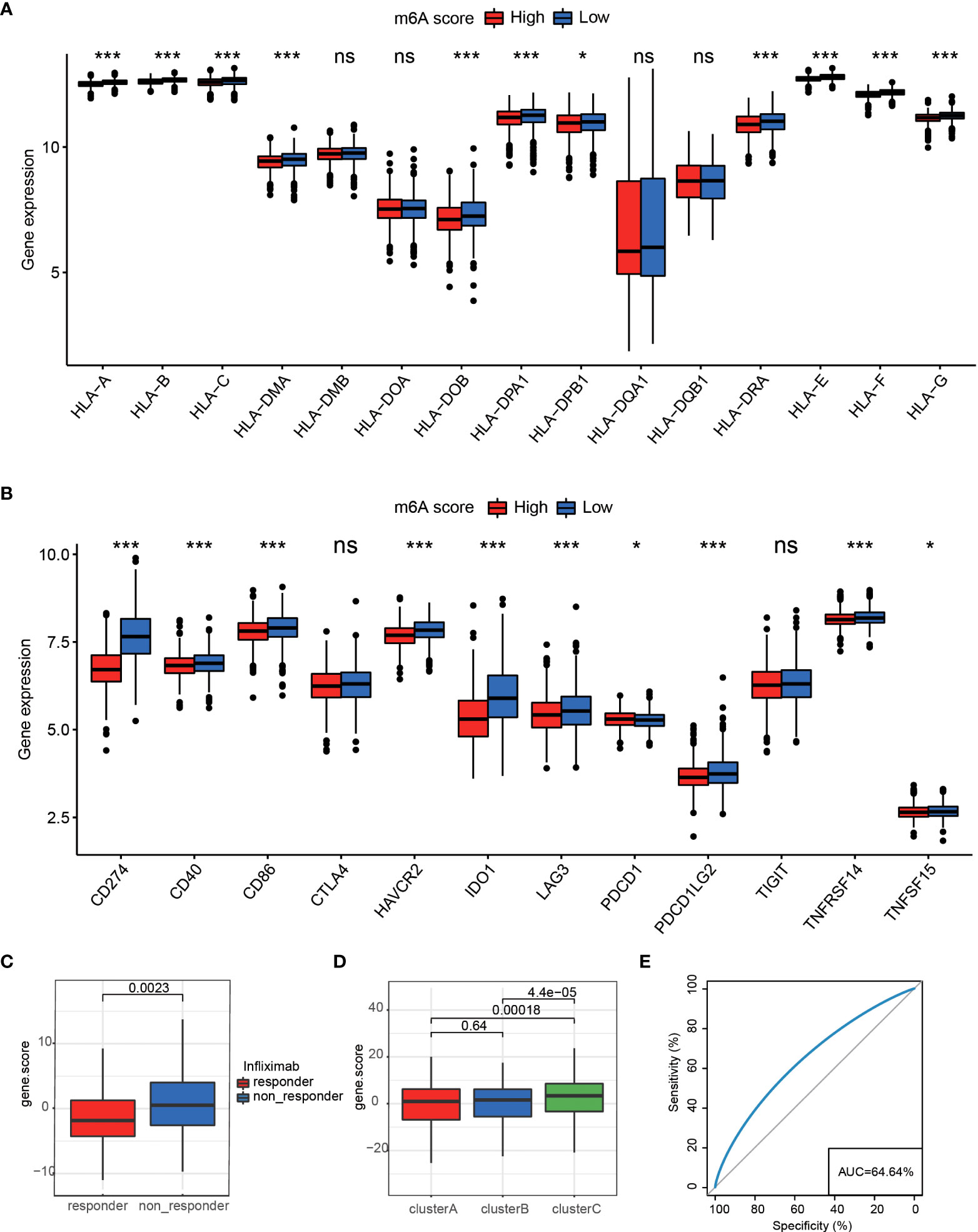
Figure 6 (A) The expression differences of HLA between two different groups *P < 0.05, ***P < 0.001, ns P>=0.05. (B) Differences in 12 critical immune checkpoints between high m6Ascore and low m6Ascore groups *P < 0.05, ***P < 0.001, ns P>=0.05. (C) M6Ascore in the infliximab treatment responder and non-responder patients. (D) M6Ascore in three m6A clusters (Wilcoxon test). (E) ROC curve of the m6Ascore in RA responder and non-responder samples, suggesting that the m6Ascore feature could predict patients’ response levels.
Heterogeneity within RA remains poorly characterized and understood; the possible reason might be that the existing classification criteria for RA do not clearly explain the heterogeneous clinical response to the different treatments. Some studies tried to search for new stratification and classification in rheumatoid arthritis. The type I interferon signature expression at baseline could predict clinical outcomes upon TNFα blockade treatment (22). Frances et al. stratified RA as B-cell-poor and B-cell-rich patients. They found that patients with a low or absent B-cell lineage expression signature in synovial tissue tocilizumab are more effective than rituximab (23). To explore the contribution of m6A subtype classification to the heterogeneity of RA, we developed an m6Ascore model to quantify the m6A modification patterns of individual RA patients. We assessed its potential predictive value in infliximab therapy.
Along with research going deep, several studies have partially unraveled the relationship between m6A modification and RA. RNA modifications play an indispensable role in autoimmune regulation through an interaction with diverse m6A regulators (24, 25). Specific deletion of m6A methyltransferases causes severe autoimmune diseases (13). Luo et al. confirmed that the expressions of peripheral blood ALKBH5, FTO, and YTHDF2 were associated with disease activity and inflammatory response (26). METTL3 serves as a potential biomarker for the diagnosis of RA due to its significant inhibition of the inflammatory response of macrophages (27). Therefore, identifying the roles of m6A modification patterns in RA will help understand the mechanisms of m6A in RA, providing insights into the prediction of the efficacy of immunotherapy strategies.
First of all, we identified the distinct expression of the m6A regulator pattern of RA patients. The classifier based on 20 m6A regulators could distinguish RA and healthy individuals, reaffirming the critical role of m6A regulators in RA. Then, we identified three distinct RNA modification patterns correlated with different immune phenotypes. Considering that stratification methods are not clinically practical enough, we established a scoring system to quantify the m6A modification patterns of individuals and accurately reflected the m6A regulator modification pattern in RA. We found that the m6A score not only played a non-negligible role in shaping different m6A methylation modification patterns but also might define clinically meaningful subgroups of RA patients with distinct responses to therapeutic agents. Patients sensitive to infliximab therapy were significantly related to a lower m6A score. Interestingly, the predictive value of the m6A score in rituximab-treated cohorts has not been observed. Previous studies found inherent molecular signatures in RA patients, independent of disease severity and which could not be entirely normalized with current symptomatic treatments (28). In addition, the feature is associated with resistance to drug treatments, which are primarily explained by the imbalance of immune cell subsets (28). In our results, RA was classified into three clusters, (A) highest inflammatory phenotype, (B) innate lymphocyte-rich phenotype, and (C) adaptive lymphocyte-rich phenotype, and there was no differential distribution of disease activity scores between clusters. Cluster A showed strong inflammatory features including a left shift in neutrophil- and monocyte-activated complement pathways. Tasaki et al. found that transcriptional changes induced by infliximab treatments mainly occurred in genes expressed in neutrophils (28). Furthermore, one study also reported good responders for infliximab-exhibited mobilization of neutrophils and monocytes, whereas poor responders showed a high expression of activated B-cell genes (29). In contrast, cluster C showed the lowest levels in nearly all inflammatory cells and pathways and had abundant activated B-cell and immature B-cell infiltration, which could be important reasons for cluster C patients with an unfavorable response to infliximab. The highest m6A score implies a worse response to infliximab in our results. Additionally, cluster A has been significantly activated in the mTOR signaling pathway, reported in several chronic inflammatory diseases. The inhibition of mTOR has shown moderate efficacy in reducing joint inflammation (30). Cluster B is an interesting subgroup, which was modestly activated with neutrophils, monocytes, and B cells. However, its m6A score is comparable to cluster A. Except for neutrophils, Tasaki et al. also found that the second most informative cell type in the infliximab response model was NK (28). Infliximab was observed to bind firmly to CD14dim monocytes, granulocytes, and NK cells, hardly binding to CD8+ T cells or B cells, which might be related to expressing higher levels of membrane TNF (mTNF) in RA patients (31). Infliximab induces potent anti-inflammatory responses through TNF (32). In this context, the response to infliximab of cluster BC may be related to the highest activation with innate lymphocytes represented by NK.
M6A-related gene signatures were used for pathway enrichment analysis and found to have significant differences in innate immune responses among the three clusters, consistent with characteristics of immune cell infiltration. Plenty of studies have revealed nucleotide-binding and oligomerization domain (NOD)-like receptors (NLRs) to play essential roles in autoimmune diseases including RA (33, 34). In addition, increasing studies have reported a role for type I IFNs (interferons) in the pathogenesis of different subsets of RA patients, indicating that IFN-α/βactivity may have essential clinical utility in predicting response to tumor necrosis factor antagonists (35–37). Chen et al. also found that the expression of m6A phenotype-related hub genes might predict a therapeutic response to anti-TNF therapy in inflammatory bowel disease (38). Previous studies have demonstrated that m6A involves the progression of the inflammatory response by affecting TNF-α degradation and regulation. The knockdown of METTL14 led to the inhibition of the TNF-α-induced cell senescence (39), endothelial inflammation, and atherosclerosis development (40). Tong et al. have confirmed that METTL3-deficient macrophages exhibited reduced TNF-α production upon LPS stimulation in vitro (41). YTHDF2 knockdown significantly increased the LPS-induced IL-6, TNF-α, IL-1β, and IL-12 expression (42), accompanied by increased TNF receptor superfamily member 1b (TNFRSF1b) mRNA (43).
Our study is the first to systematically analyze the relationship between m6A regulators and rheumatoid arthritis. We identified three distinct m6A methylation modification patterns and constructed a scoring model which demonstrated clinical utility for the m6A score as a biomarker in the prediction of arthritis infliximab therapy, which are likely to be useful in future studies exploring m6A epigenetic modification in RA and potentially enabling improved therapeutic decisions and more reliable prediction of response to therapy. Nevertheless, it can hardly be denied that this study had some limitations. This study is based on bioinformatics analysis, and many results theoretically need to be verified by subsequent experiments like m6Aseq, LC-MS, and MeRIP seq.
The data presented in the study are deposited in the National Genomics Data Center, China National Center for Bioinformation repository (https://ngdc.cncb.ac.cn), accession number PRJCA010630.
The studies involving human participants were reviewed and approved by The Ethics Committee of the Second Hospital of Shanxi Medical University (2016 KY-007). The patients/participants provided their written informed consent to participate in this study.
Study design and manuscript writing: SS and RZ. Data extraction, quality assessment, analysis, and interpretation of data: SS, RZ, JQ, JL, and TC. Financial support and review: S-XZ, and X-FL. All authors were involved in drafting the article or revising it critically for important intellectual content, and all authors approved the final version to be published. X-FL had full access to all the data in the study and took responsibility for the integrity of the data and the accuracy of the data analysis.
The authors disclosed receipt of the following financial support for the research, authorship, and publication of this article: this work was supported by the National Natural Science Foundation of China (No. 82001740).
The authors declare that the research was conducted in the absence of any commercial or financial relationships that could be construed as a potential conflict of interest.
All claims expressed in this article are solely those of the authors and do not necessarily represent those of their affiliated organizations, or those of the publisher, the editors and the reviewers. Any product that may be evaluated in this article, or claim that may be made by its manufacturer, is not guaranteed or endorsed by the publisher.
The Supplementary Material for this article can be found online at: https://www.frontiersin.org/articles/10.3389/fimmu.2022.940918/full#supplementary-material
1. Sparks JA. Rheumatoid arthritis. Ann Intern Med (2019) 170(1):ITC1–ITC16. doi: 10.7326/AITC201901010
2. Scherer HU, Haupl T, Burmester GR. The etiology of rheumatoid arthritis. J Autoimmun (2020) 110:102400. doi: 10.1016/j.jaut.2019.102400
3. Smolen JS, Aletaha D, Barton A, Burmester GR, Emery P, Firestein GS, et al. Rheumatoid arthritis. Nat Rev Dis Primers (2018) 4:18001. doi: 10.1038/nrdp.2018.1
4. Doody KM, Bottini N, Firestein GS. Epigenetic alterations in rheumatoid arthritis fibroblast-like synoviocytes. Epigenomics (2017) 9(4):479–92. doi: 10.2217/epi-2016-0151
5. Burmester GR, Pope JE. Novel treatment strategies in rheumatoid arthritis. Lancet (2017) 389(10086):2338–48. doi: 10.1016/S0140-6736(17)31491-5
6. Melville AR, Kearsley-Fleet L, Buch MH, Hyrich KL. Understanding refractory rheumatoid arthritis: Implications for a therapeutic approach. Drugs (2020) 80(9):849–57. doi: 10.1007/s40265-020-01309-9
7. Boccaletto P, Machnicka MA, Purta E, Piatkowski P, Baginski B, Wirecki TK, et al. MODOMICS: A database of RNA modification pathways. 2017 update. Nucleic Acids Res (2018) 46(D1):D303–D7. doi: 10.1093/nar/gkx1030
8. He L, Li H, Wu A, Peng Y, Shu G, Yin G. Functions of N6-methyladenosine and its role in cancer. Mol Cancer (2019) 18(1):176. doi: 10.1186/s12943-019-1109-9
9. Wang X, Zhao BS, Roundtree IA, Lu Z, Han D, Ma H, et al. N(6)-methyladenosine modulates messenger RNA translation efficiency. Cell (2015) 161(6):1388–99. doi: 10.1016/j.cell.2015.05.014
10. Chen XY, Zhang J, Zhu JS. The role of m(6)A RNA methylation in human cancer. Mol Cancer (2019) 18(1):103. doi: 10.1186/s12943-019-1033-z
11. Tong J, Flavell RA, Li HB. RNA m(6)A modification and its function in diseases. Front Med (2018) 12(4):481–9. doi: 10.1007/s11684-018-0654-8
12. Wang S, Sun C, Li J, Zhang E, Ma Z, Xu W, et al. Roles of RNA methylation by means of N(6)-methyladenosine (m(6)A) in human cancers. Cancer Lett (2017) 408:112–20. doi: 10.1016/j.canlet.2017.08.030
13. Tong J, Cao G, Zhang T, Sefik E, Amezcua Vesely MC, Broughton JP, et al. m(6)A mRNA methylation sustains treg suppressive functions. Cell Res (2018) 28(2):253–6. doi: 10.1038/cr.2018.7
14. Li LJ, Fan YG, Leng RX, Pan HF, Ye DQ. Potential link between m(6)A modification and systemic lupus erythematosus. Mol Immunol (2018) 93:55–63. doi: 10.1016/j.molimm.2017.11.009
15. Glant TT, Mikecz K, Rauch TA. Epigenetics in the pathogenesis of rheumatoid arthritis. BMC Med (2014) 12:35. doi: 10.1186/1741-7015-12-35
16. Mo XB, Zhang YH, Lei SF. Genome-wide identification of N(6)-methyladenosine (m(6)A) SNPs associated with rheumatoid arthritis. Front Genet (2018) 9:299. doi: 10.3389/fgene.2018.00299
17. Aletaha D, Neogi T, Silman AJ, Funovits J, Felson DT, Bingham CO 3rd, et al. 2010 rheumatoid arthritis classification criteria: an American college of Rheumatology/European league against rheumatism collaborative initiative. Ann Rheum Dis (2010) 69(9):1580–8. doi: 10.1136/ard.2010.138461
18. Zhang B, Wu Q, Li B, Wang D, Wang L, Zhou YL. m(6)A regulator-mediated methylation modification patterns and tumor microenvironment infiltration characterization in gastric cancer. Mol Cancer (2020) 19(1):53. doi: 10.1186/s12943-020-01170-0
19. Zaccara S, Ries RJ, Jaffrey SR. Reading, writing and erasing mRNA methylation. Nat Rev Mol Cell Biol (2019) 20(10):608–24. doi: 10.1038/s41580-019-0168-5
20. Shen X, Hu B, Xu J, Qin W, Fu Y, Wang S, et al. The m6A methylation landscape stratifies hepatocellular carcinoma into 3 subtypes with distinct metabolic characteristics. Cancer Biol Med (2020) 17(4):937–52. doi: 10.20892/j.issn.2095-3941.2020.0402
21. Zeng D, Li M, Zhou R, Zhang J, Sun H, Shi M, et al. Tumor microenvironment characterization in gastric cancer identifies prognostic and immunotherapeutically relevant gene signatures. Cancer Immunol Res (2019) 7(5):737–50. doi: 10.1158/2326-6066.CIR-18-0436
22. Rodriguez-Carrio J, Alperi-Lopez M, Lopez P, Ballina-Garcia FJ, Suarez A. Heterogeneity of the type I interferon signature in rheumatoid arthritis: A potential limitation for its use as a clinical biomarker. Front Immunol (2017) 8:2007. doi: 10.3389/fimmu.2017.02007
23. Humby F, Durez P, Buch MH, Lewis MJ, Rizvi H, Rivellese F, et al. Rituximab versus tocilizumab in anti-TNF inadequate responder patients with rheumatoid arthritis (R4RA): 16-week outcomes of a stratified, biopsy-driven, multicentre, open-label, phase 4 randomised controlled trial. Lancet (2021) 397(10271):305–17. doi: 10.1016/S0140-6736(20)32341-2
24. Zheng Q, Hou J, Zhou Y, Li Z, Cao X. The RNA helicase DDX46 inhibits innate immunity by entrapping m(6)A-demethylated antiviral transcripts in the nucleus. Nat Immunol (2017) 18(10):1094–103. doi: 10.1038/ni.3830
25. Fan D, Xia Y, Lu C, Ye Q, Xi X, Wang Q, et al. Regulatory role of the RNA N(6)-methyladenosine modification in immunoregulatory cells and immune-related bone homeostasis associated with rheumatoid arthritis. Front Cell Dev Biol (2020) 8:627893. doi: 10.3389/fcell.2020.627893
26. Luo Q, Gao Y, Zhang L, Rao J, Guo Y, Huang Z, et al. Decreased ALKBH5, FTO, and YTHDF2 in peripheral blood are as risk factors for rheumatoid arthritis. BioMed Res Int (2020) 2020:5735279. doi: 10.1155/2020/5735279
27. Wang J, Yan S, Lu H, Wang S, Xu D. METTL3 attenuates LPS-induced inflammatory response in macrophages via NF-kappaB signaling pathway. Mediators Inflamm (2019) 2019:3120391. doi: 10.1155/2019/3120391
28. Tasaki S, Suzuki K, Kassai Y, Takeshita M, Murota A, Kondo Y, et al. Multi-omics monitoring of drug response in rheumatoid arthritis in pursuit of molecular remission. Nat Commun (2018) 9(1):2755. doi: 10.1038/s41467-018-05044-4
29. MacIsaac KD, Baumgartner R, Kang J, Loboda A, Peterfy C, DiCarlo J, et al. Pre-treatment whole blood gene expression is associated with 14-week response assessed by dynamic contrast enhanced magnetic resonance imaging in infliximab-treated rheumatoid arthritis patients. PloS One (2014) 9(12):e113937. doi: 10.1371/journal.pone.0113937
30. Suto T, Karonitsch T. The immunobiology of mTOR in autoimmunity. J Autoimmun (2020) 110:102373. doi: 10.1016/j.jaut.2019.102373
31. Coulthard LR, Geiler J, Mathews RJ, Church LD, Dickie LJ, Cooper DL, et al. Differential effects of infliximab on absolute circulating blood leucocyte counts of innate immune cells in early and late rheumatoid arthritis patients. Clin Exp Immunol (2012) 170(1):36–46. doi: 10.1111/j.1365-2249.2012.04626.x
32. Mitoma H, Horiuchi T, Hatta N, Tsukamoto H, Harashima S, Kikuchi Y, et al. Infliximab induces potent anti-inflammatory responses by outside-to-inside signals through transmembrane TNF-alpha. Gastroenterology (2005) 128(2):376–92. doi: 10.1053/j.gastro.2004.11.060
33. Shen HH, Yang YX, Meng X, Luo XY, Li XM, Shuai ZW, et al. NLRP3: A promising therapeutic target for autoimmune diseases. Autoimmun Rev (2018) 17(7):694–702. doi: 10.1016/j.autrev.2018.01.020
34. Chen L, Cao SQ, Lin ZM, He SJ, Zuo JP. NOD-like receptors in autoimmune diseases. Acta Pharmacol Sin (2021) 42(11):1742–56. doi: 10.1038/s41401-020-00603-2
35. Lubbers J, Brink M, van de Stadt LA, Vosslamber S, Wesseling JG, van Schaardenburg D, et al. The type I IFN signature as a biomarker of preclinical rheumatoid arthritis. Ann Rheum Dis (2013) 72(5):776–80. doi: 10.1136/annrheumdis-2012-202753
36. Mavragani CP, La DT, Stohl W, Crow MK. Association of the response to tumor necrosis factor antagonists with plasma type I interferon activity and interferon-beta/alpha ratios in rheumatoid arthritis patients: A post hoc analysis of a predominantly Hispanic cohort. Arthritis Rheumatol (2010) 62(2):392–401. doi: 10.1002/art.27226
37. Thurlings RM, Boumans M, Tekstra J, van Roon JA, Vos K, van Westing DM, et al. Relationship between the type I interferon signature and the response to rituximab in rheumatoid arthritis patients. Arthritis Rheumatol (2010) 62(12):3607–14. doi: 10.1002/art.27702
38. Chen Y, Lei J, He S. m(6)A modification mediates mucosal immune microenvironment and therapeutic response in inflammatory bowel disease. Front Cell Dev Biol (2021) 9:692160. doi: 10.3389/fcell.2021.692160
39. Zhu H, Sun B, Zhu L, Zou G, Shen Q. N6-methyladenosine induced miR-34a-5p promotes TNF-alpha-Induced nucleus pulposus cell senescence by targeting SIRT1. Front Cell Dev Biol (2021) 9:642437. doi: 10.3389/fcell.2021.642437
40. Jian D, Wang Y, Jian L, Tang H, Rao L, Chen K, et al. METTL14 aggravates endothelial inflammation and atherosclerosis by increasing FOXO1 N6-methyladeosine modifications. Theranostics (2020) 10(20):8939–56. doi: 10.7150/thno.45178
41. Tong J, Wang X, Liu Y, Ren X, Wang A, Chen Z, et al. Pooled CRISPR screening identifies m(6)A as a positive regulator of macrophage activation. Sci Adv (2021) 7(18):eabd4742. doi: 10.1126/sciadv.abd4742
42. Yu R, Li Q, Feng Z, Cai L, Xu Q. m6A reader YTHDF2 regulates LPS-induced inflammatory response. Int J Mol Sci (2019) 20(6):1323. doi: 10.3390/ijms20061323
Keywords: rheumatoid arthritis, epigenetic, m6A RNA modification, immune microenvironment, infliximab
Citation: Song S, Zhao R, Qiao J, Liu J, Cheng T, Zhang S-X and Li X-F (2022) Predictive value of drug efficacy by M6A modification patterns in rheumatoid arthritis patients. Front. Immunol. 13:940918. doi: 10.3389/fimmu.2022.940918
Received: 10 May 2022; Accepted: 19 July 2022;
Published: 16 August 2022.
Edited by:
Yudong Liu, Chinese Academy of Medical Sciences, ChinaReviewed by:
Haijing Wu, Second Xiangya Hospital, Central South University, ChinaCopyright © 2022 Song, Zhao, Qiao, Liu, Cheng, Zhang and Li. This is an open-access article distributed under the terms of the Creative Commons Attribution License (CC BY). The use, distribution or reproduction in other forums is permitted, provided the original author(s) and the copyright owner(s) are credited and that the original publication in this journal is cited, in accordance with accepted academic practice. No use, distribution or reproduction is permitted which does not comply with these terms.
*Correspondence: Xiao-Feng Li, bHhmXzk4NTlAc3htdS5lZHUuY24=
Disclaimer: All claims expressed in this article are solely those of the authors and do not necessarily represent those of their affiliated organizations, or those of the publisher, the editors and the reviewers. Any product that may be evaluated in this article or claim that may be made by its manufacturer is not guaranteed or endorsed by the publisher.
Research integrity at Frontiers

Learn more about the work of our research integrity team to safeguard the quality of each article we publish.